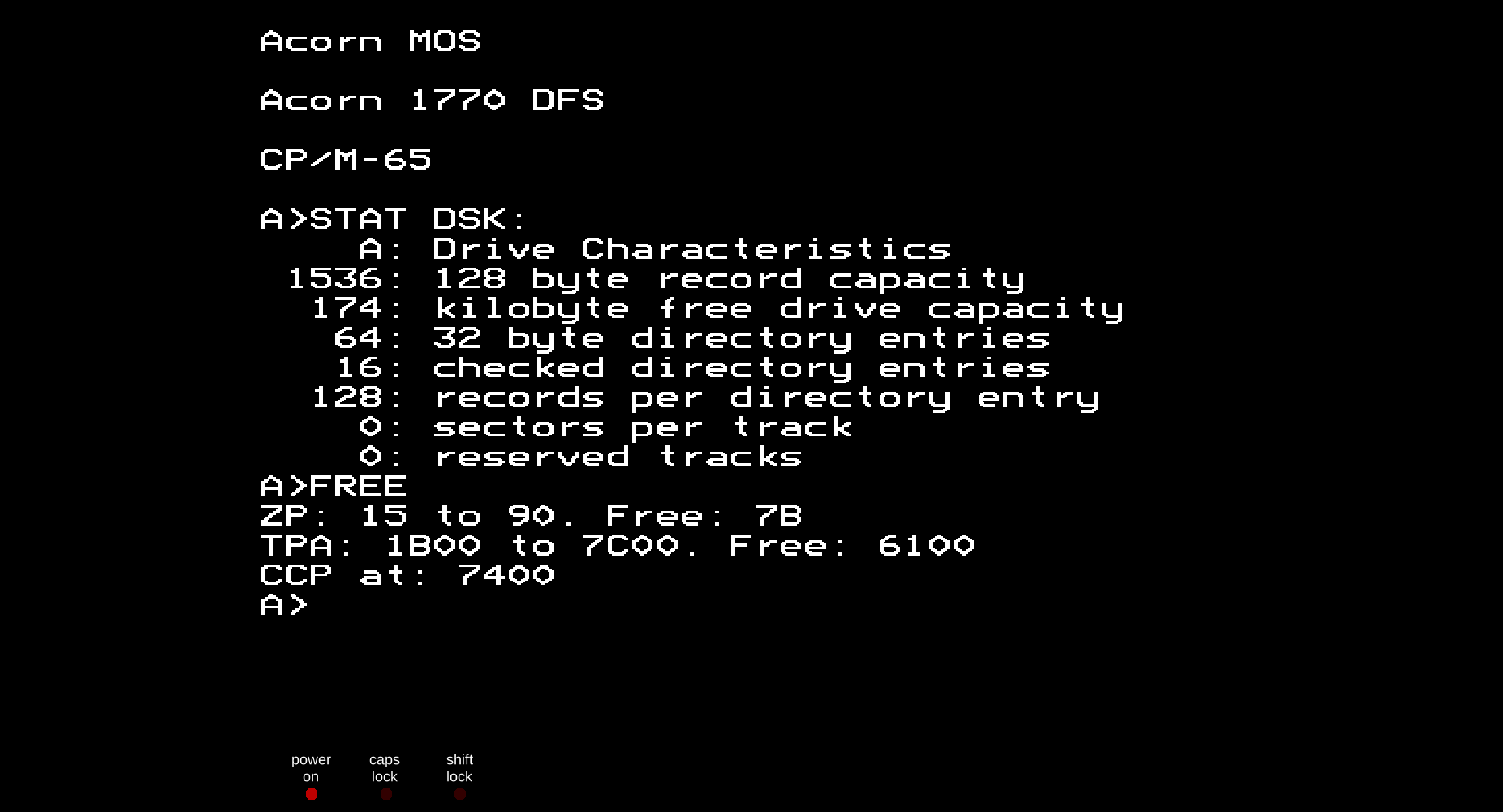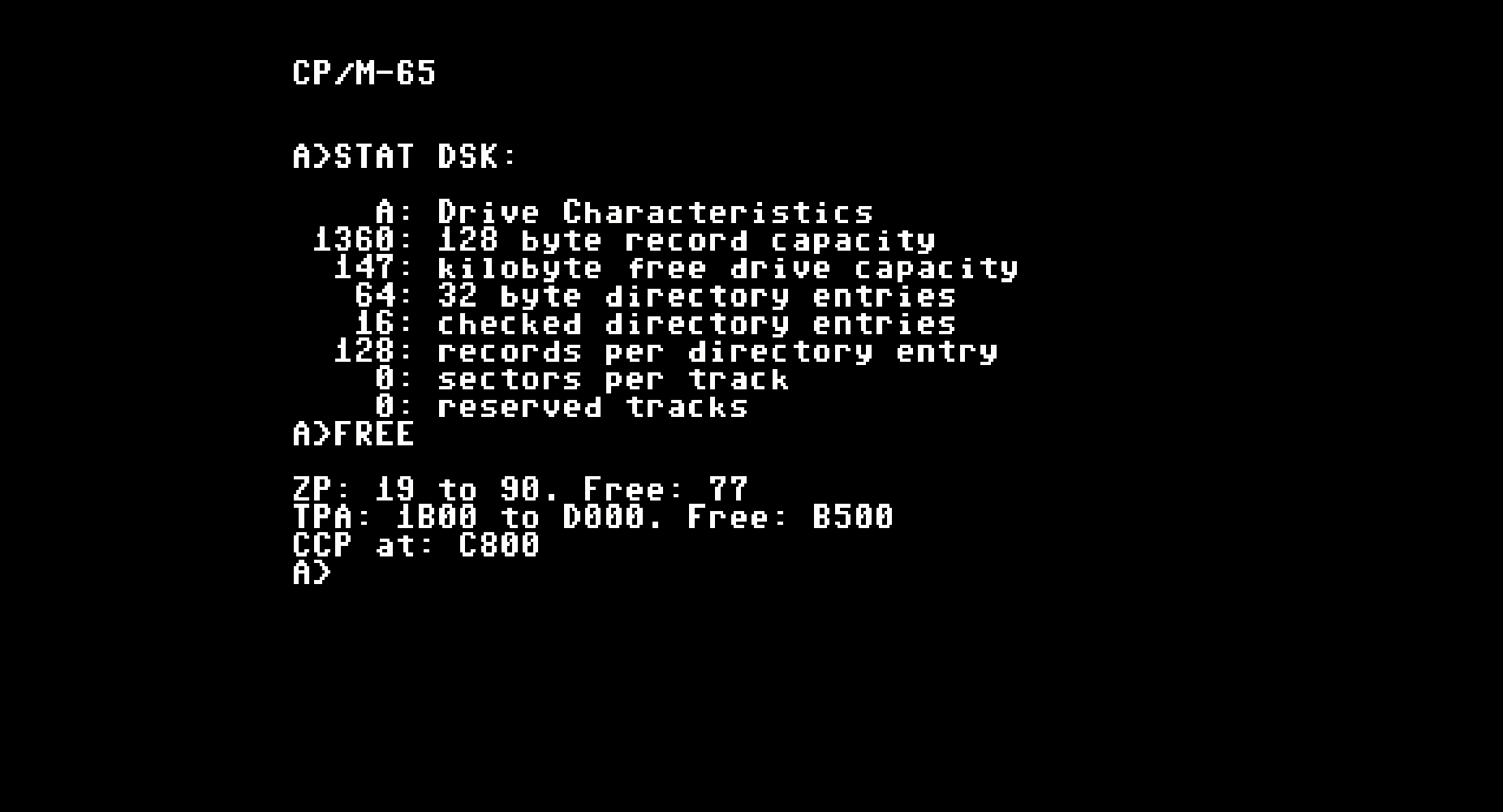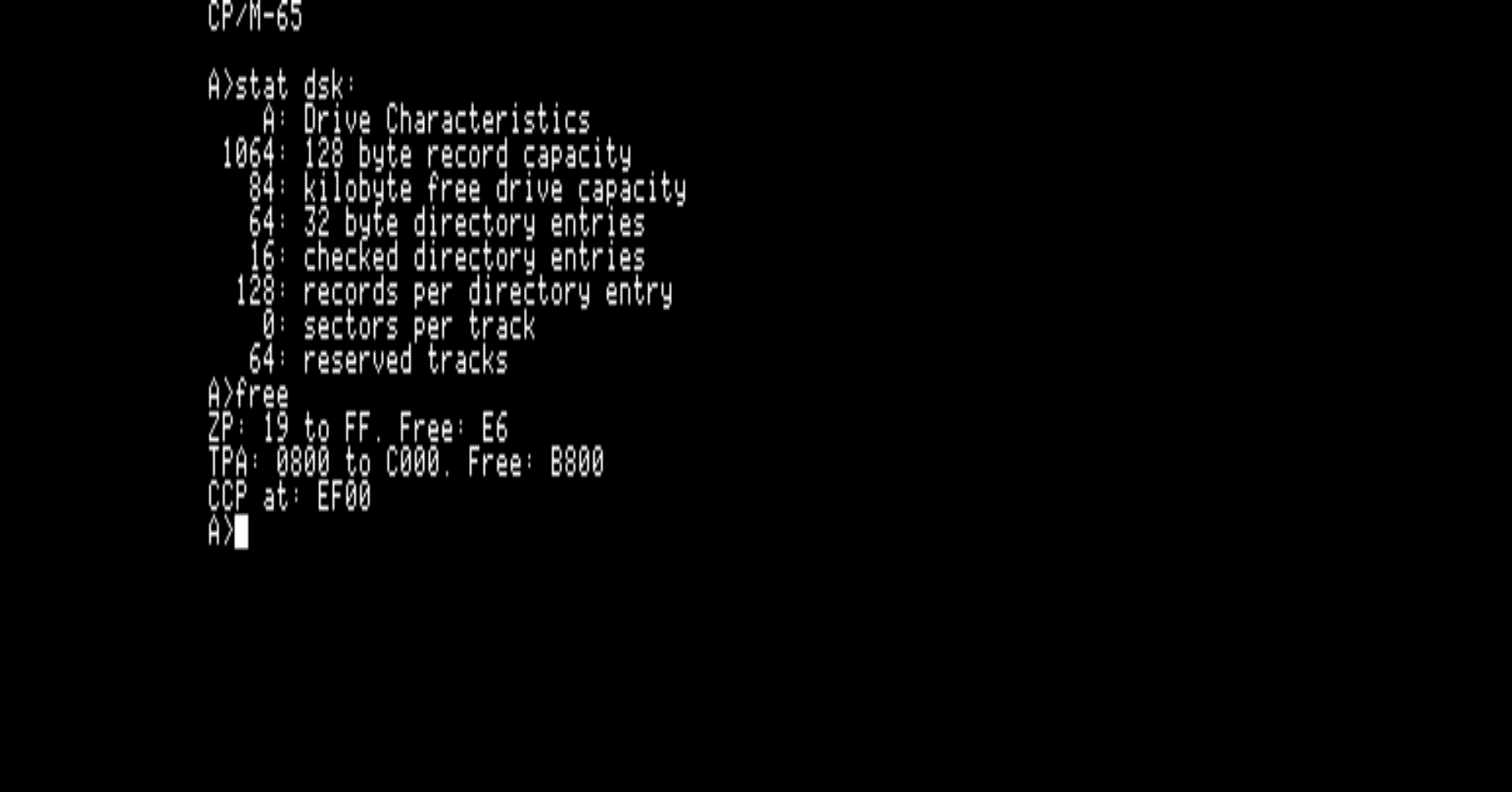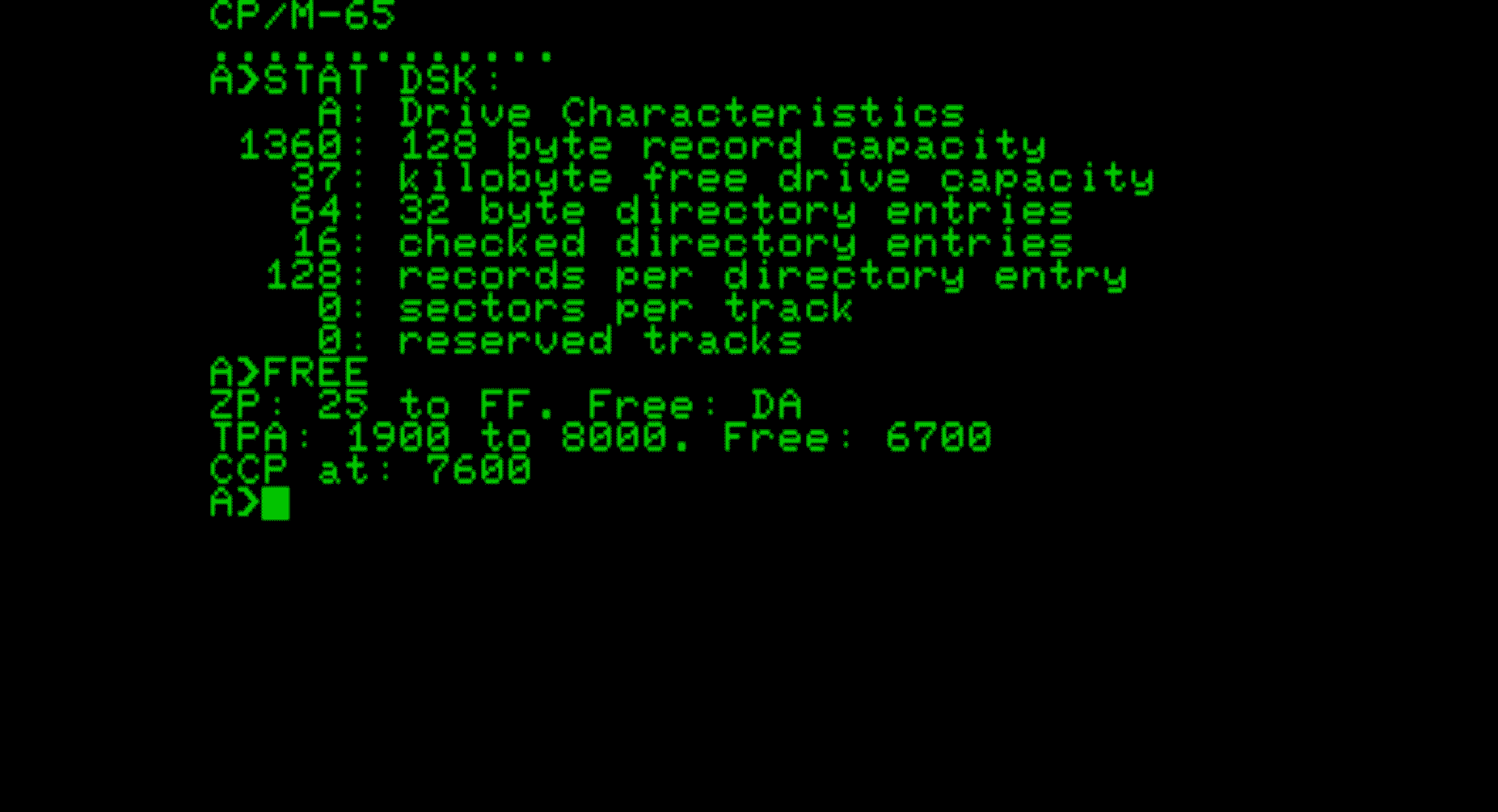|
|
2 years ago | |
|---|---|---|
| .github/workflows | 2 years ago | |
| apps | 2 years ago | |
| cpmfs | 2 years ago | |
| doc | 2 years ago | |
| include | 2 years ago | |
| lib | ||
| scripts | 2 years ago | |
| src | 2 years ago | |
| third_party | ||
| tools | 2 years ago | |
| .clang-format | ||
| .hgignore | ||
| LICENSE | ||
| Makefile | 2 years ago | |
| README.md | 2 years ago | |
| diskdefs | ||
README.md
CP/M-65
What?
This is a native port of Digital Research's seminal 1977 operating system CP/M to the 6502. So far it runs on:
-
The BBC Micro family, including Master, Tube, and Electron; TPA ranges from 14kB on the Electron to 57kB on the Tube.
-
Commodore 64; TPA is 46kB.
-
Commodore PET 4032; TPA is 26kB --- the assembler will run, just.
-
Commander X16; TPA is 46kB.
-
Apple IIe; TPA is 46kB.
Unlike the original, it supports relocatable binaries, so allowing unmodified binaries to run on any system: this is necessary as 6502 systems tend to be much less standardised than 8080 and Z80 systems. (The systems above all load programs at different base addresses.)
Currently you can cross-assemble programs from a PC, as well as a working C toolchain with llvm-mos. For native development, there's a basic assembler but currently no (functioning) editor. You need about 20kB to run the assembler at all, and of course more memory the bigger the program.
No, it won't let you run 8080 programs on the 6502!
Why?
Why not?
Where?
How?
You will need the llvm-mos toolchain. CP/M-65 support is available out of the box. Once installed, you should just be able to run the Makefile and you'll get bootable disk images for the Commodore 64 (with 1541 drive) and BBC Micro (producing a 200kB SSSD DFS disk).
BBC Micro notes
-
It'll autodetect the amount of available memory. If you're on a Master or Tube system, I'd suggest making sure you're in mode 0 or 3 before running. On a BBC Micro... well, it will run in mode 0, but you'll only get a 2.5kB TPA! I suggest mode 7. On the Electron you have to use mode 6 which gives you 14kB of TPA, which isn't enough to run the assembler.
-
The CP/M file system is stored in a big file (called cpmfs). This will expand up to the size defined in diskdefs: currently, 192kB (the largest that will fit on a SSSD disk). All disk access is done through MOS so you should be able to use a ramdisk, hard disk, Econet, ADFS, VDFS, etc. If so, you'll want to define your own disk format and adjust the drive definition in the BIOS to get more space.
Commodore 64 notes
-
Load and run the
CPMprogram to start. -
It's excruciatingly slow as it uses normal 1541 disk accesses at 300 bytes per second. Everything works, but you won't enjoy it. At some point I want to add a fastloader.
-
The disk image produced is a hybrid of a CP/M file system and a CBMDOS file system, which can be accessed as either. The disk structures used by the other file system are hidden. You get about 170kB on a normal disk.
-
Disk accesses are done using direct block access, so it won't work on anything other than a 1541. Sorry.
Commodore PET notes
-
You need a PET 4032 (no other model) and, probably, a 4040 disk drive. The disk image is for a 35-track SSSD system (I made it with cc1541). You could probably adapt things to work on other disk systems or other systems easily; the top end PET floppy drives could store a megabyte on a disk and would go nicely with the 8032's 80-column display.
-
This is set up for the Graphics Keyboard, which was a bad idea, but that's what my emulator was set up for. If you actually want to do anything with it, ask me and I'll do a Business Keyboard keymap. (Or I could emulate the Business Keyboard on the Graphics Keyboard.)
-
It's faster than the Comodore 64 version, but still not brilliant --- but you can run the assembler in real time without having to worry about retirement.
-
It supports drive 0: only.
-
This port runs completely bare-metal and does not use any ROM routines.
Commander X16 notes
-
To use, place the contents of the
x16.zipfile on the X16's SD card. Load and run theCPMprogram to start. -
The CP/M filesystem is stored in a big file called CPMFS. It needs support for the Position command in order to seek within the file.
x16emucurrently doesn't support this in its host filesystem, so you'll need to use an actual SD card image. (I have a pull request outstanding to add support. An SD2IEC should work too, as these support the same commands. However a real Commodore disk drive will not work.
Apple IIe notes
-
To use, place the contents of the
appleiie.pofile onto a disk and boot it. The disk image has been munged according to ProDOS sector ordering. -
It supports a single drive on slot 6 drive 1. You need a 80-column card (but not any aux memory).
-
This port runs completely bare-metal and does not use any ROM routines.
Supported programs
You don't get a lot right now. As transients, you get DUMP, STAT, COPY,
SUBMIT and ASM. I'd love more --- send me pull requests! The build system
supports cc65 assembler and llvm-mos C programs.
In the CCP, you get the usual DIR, ERA, TYPE and USER. There is no
SAVE as on the relocatable CP/M-65 system assembling images in memory is of
questionable utility, but there's a new FREE command which shows memory
usage.
Pokey the Penguin loves to read your pull requests!
The assembler
The CP/M-65 assembler is extremely simple and very much customised to work for the CP/M-65 environment. It operates entirely in memory (so it should be fast) but it's written in C (so it's going to be big and slow). It's very very new and is likely to have lots of bugs. There is, at least, a port of the DUMP program to it which assembles, works, and is ready to play with.
Go read cpmfs/asm.txt for the documentation.
Utilities
bin/cpmemu contains a basic CP/M-65 user mode emulator and debugger. It'll run
programs on the host environment with an emulated disk, which is very useful for
testing and development. To use:
./bin/cpmemu .obj/dump.com diskdefs
Add -d at the front of the command line to drop into the debugger --- use ?
for basic help. It can only access 8.3-format all-lowercase filenames in the
current directory, but you can also map drives. Use -h for help.
Who?
You may contact me at dg@cowlark.com, or visit my website at http://www.cowlark.com. There may or may not be anything interesting there. The CP/M-65 project was designed and written by me, David Given.
License
Everything here so far except the contents of the third_party directory is
© 2022-2023 David Given, and is licensed under the two-clause BSD open source
license. Please see LICENSE for the full text. The tl;dr is: you can
do what you like with it provided you don't claim you wrote it.
The exceptions are the contents of the third_party directory, which were
written by other people and are not covered by this license. This directory as
a whole contains GPL software, which means that if you redistribute the entire
directory, you must conform to the terms of the GPL.
third_party/lib6502 contains a hacked copy of the lib6502 library, which is ©
2005 Ian Plumarta and is available under the terms of the MIT license. See
third_party/lib6502/COPYING.lib6502 for the full text.




